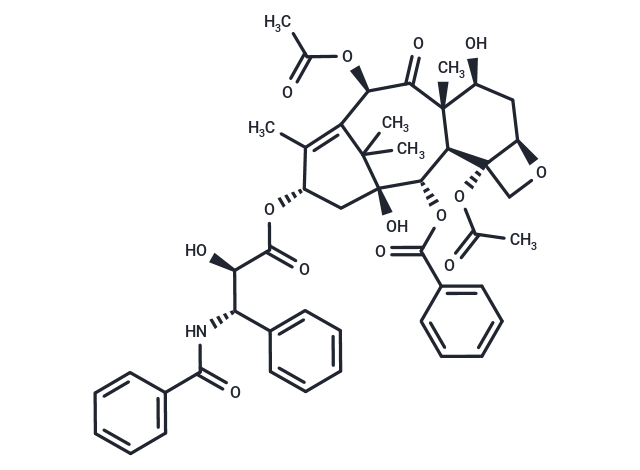Shopping Cart
Remove All Your shopping cart is currently empty
Your shopping cart is currently empty
Paclitaxel (Taxol) is a natural product and a microtubule polymer stabilizer. Paclitaxel has anti-tumor activity and causes cell death by inducing mitotic arrest, apoptosis, and cell autophagy.

| Pack Size | Price | USA Warehouse | Global Warehouse | Quantity |
|---|---|---|---|---|
| 25 mg | $34 | In Stock | In Stock | |
| 50 mg | $48 | In Stock | In Stock | |
| 100 mg | $78 | In Stock | In Stock | |
| 500 mg | $118 | In Stock | In Stock | |
| 1 g | $173 | In Stock | In Stock | |
| 1 mL x 10 mM (in DMSO) | $50 | In Stock | In Stock |
| Description | Paclitaxel (Taxol) is a natural product and a microtubule polymer stabilizer. Paclitaxel has anti-tumor activity and causes cell death by inducing mitotic arrest, apoptosis, and cell autophagy. |
| Targets&IC50 | C6 cells:3.1 nM, 1A9 cells:0.002 μM, 4T1 cells:0.001 mM, Microtubule:4 nM, 184B5 cells:2.32 μM, 1A9/ptx-22 cells:160.7 nM, A375 cells:0.002 μM, B16 cells:0.04 μM, A121 cells:6.1 nM, CCRF-HSB-2 cells:0.25 µM, HeLa cells:0.001 μM, 143B cells:5.56 μM, A431 cells:0.001 μM, 1A9/ptx-10 cells:157 nM, 769-P cells:7.1 μM |
| In vitro | METHODS: Human T-cell lymphoblastic leukemia cells CCRF-HSB-2 were treated with Paclitaxel (0.01-1 µM) for 48 h. Cell growth inhibition was detected by MTT. RESULTS: Paclitaxel dose-dependently inhibited the growth of CCRF-HSB-2 cells with an IC50 of 0.25 µM.[1] METHODS: Human gastric cancer cells AGS were treated with Paclitaxel (10-160 nM) for 24-48 h. The expression levels of target proteins were detected by Western Blot. RESULTS: Paclitaxel induced the up-regulation of the expression of cleaved caspase-3 and cleaved PARP, which are apoptosis-related proteins. [2] METHODS: Canine mammary tumor cells CHMm were treated with Paclitaxel (0.01-1 μM) for 24 h. Apoptosis was detected using Flow Cytometry. RESULTS: Paclitaxel dose-dependently induced apoptosis in CHMm cells. [3] |
| In vivo | METHODS: To investigate the effect of low-dose Paclitaxel on tumor invasion, Paclitaxel (2.6 mg/kg) was administered intraperitoneally to SCID mice bearing cholangiocarcinoma tumor EGI-1 once daily for two weeks. RESULTS: Low-dose Paclitaxel treatment reduced the pulmonary spread of EGI-1 cells without significantly affecting their local tumor growth. [4] METHODS: To develop a preclinical model of Paclitaxel alcohol-induced negative affective symptoms, Paclitaxel (2-8 mg/kg in 1 volume ethanol+1 volume Emulphor-620 +18 volumes distilled water) was injected intraperitoneally into C57BL/6J mice every four injections were given to C57BL/6J mice once every two days. RESULTS: 8 mg/kg Paclitaxel treatment resulted in the development and maintenance of mechanical and cold abnormalities of pain. Paclitaxel also induced anxiety-like and depressive-like behaviors. Paclitaxel produced behavioral changes in the mouse affective state modeling assay, whereas the increase in injurious responses lasted longer. [5] |
| Kinase Assay | To determine which caspases are involved in apoptosis induced by taxol, caspase-3 inhibitor (DEVD-CHO), caspase-6 inhibitor (Z-VEID-FMK), caspase-8 inhibitor (Z-IETD-FMK or IETD-CHO), caspase-9 inhibitors (Z-LEHD-FMK or LEHD-CHO), and caspase-10 inhibitor (Z-AEVD-FMK) are used. These caspase inhibitors are dissolved in dimethyl sulfoxide (Me2SO); the final concentration of Me2SO is 0.1%. Cells (5×105) are preincubated in the presence or absence of 100 μM?each of these inhibitors for 3 h at 37°C then treated with or without 0.1, 0.5, and 1 μM?Paclitaxel for 48 h and processed for annexin V binding assay [1]. |
| Cell Research | 1×10^4 cells are plated in 100 μL of the growth medium in the presence or absence of increasing concentrations (0.1-1 μM) of taxol in 96-well plates and cultured at 37°C in 5% CO2 for 12-48 h. The cells are then incubated with 25 μL of MTT (5 mg/mL) at 37°C for 4 h. After dissolving the crystals with 0.04 N HCl in isopropanol, the plates are read in a microplate reader at 570 nm [1]. |
| Animal Research | Adult (250-320 g) male Sprague-Dawley rats are used for all experiments. One week following the DiI injection, rats are anesthetized with isofluorane and injected into the tail vein with 2 mg/kg paclitaxel or its vehicle (1:1:23, cremophor EL:ethanol:0.9% saline). The tail vein injection is repeated three more times every other day for a total of four injections [4]. |
| Synonyms | Taxol, NSC 125973 |
| Molecular Weight | 853.91 |
| Formula | C47H51NO14 |
| Cas No. | 33069-62-4 |
| Smiles | CC(=O)O[C@@H]1C2=C(C)[C@H](C[C@@](O)([C@@H](OC(=O)c3ccccc3)[C@@H]3[C@@]4(CO[C@@H]4C[C@H](O)[C@@]3(C)C1=O)OC(C)=O)C2(C)C)OC(=O)[C@H](O)[C@@H](NC(=O)c1ccccc1)c1ccccc1 |
| Relative Density. | 1.39g/cm3 |
| Color | White |
| Appearance | Solid |
| Storage | keep away from direct sunlight,store at low temperature | Powder: -20°C for 3 years | In solvent: -80°C for 1 year | Shipping with blue ice/Shipping at ambient temperature. | ||||||||||||||||||||||||||||||||||||||||
| Solubility Information | Ethanol: 21.4 mg/mL (25.06 mM), Sonication is recommended. DMSO: 257.5 mg/mL (301.55 mM), Sonication is recommended. | ||||||||||||||||||||||||||||||||||||||||
| In Vivo Formulation | 10% DMSO+40% PEG300+5% Tween 80+45% Saline: 8.54 mg/mL (10 mM), Suspension. Please add the solvents sequentially, clarifying the solution as much as possible before adding the next one. Dissolve by heating and/or sonication if necessary. Working solution is recommended to be prepared and used immediately. The formulation provided above is for reference purposes only. In vivo formulations may vary and should be modified based on specific experimental conditions. | ||||||||||||||||||||||||||||||||||||||||
Solution Preparation Table | |||||||||||||||||||||||||||||||||||||||||
Ethanol/DMSO
DMSO
| |||||||||||||||||||||||||||||||||||||||||
| Size | Quantity | Unit Price | Amount | Operation |
|---|

Copyright © 2015-2025 TargetMol Chemicals Inc. All Rights Reserved.